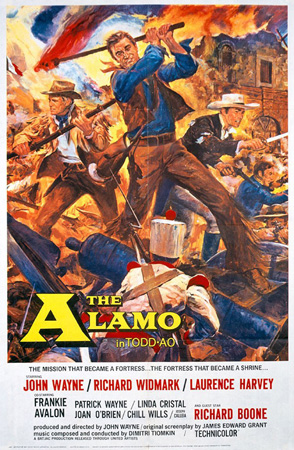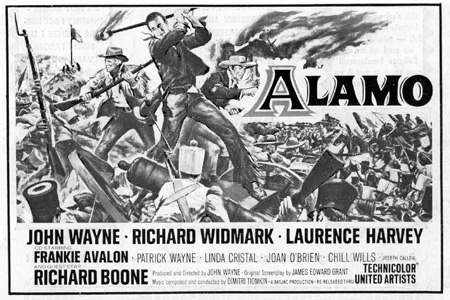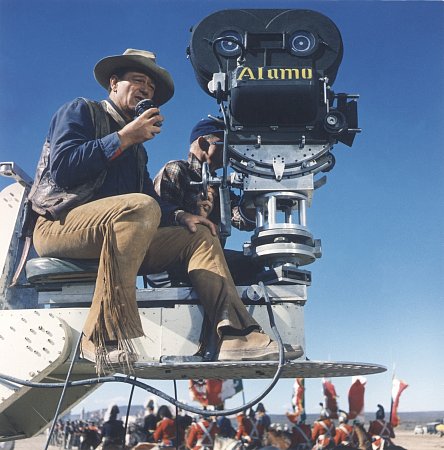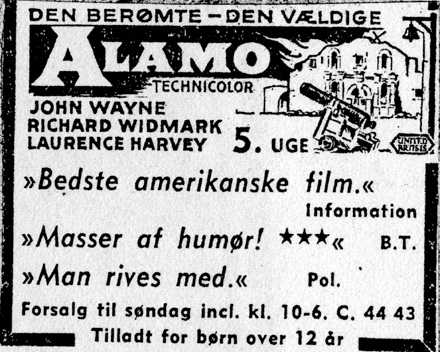The Finding Of The Lost Alamo |
Read more
at in70mm.com The 70mm Newsletter |
| Written by: Bob Bryden | Date: 01.06.2009 |
 US
1-sheet poster US
1-sheet posterIn October of 1960, John Wayne released his film of the historic siege at the Alamo. Nearly ten years had elapsed since Wayne first conceived the project and the time of it's premiere. The 192-minute film was met with mixed reaction from the critics and did very good business at the box office, but not enough to offset its huge budget. Succumbing to pressure from critics and distributors, Mr. Wayne lopped 30 minutes from the film prior to its general release. The original Alamo was never seen again. That is, until March of 1980. At that time I managed a record store in Hamilton, Ontario, Canada. I was in Toronto picking up stock and I decided to make a night of it by going to the the IMAX Theatre at Ontario Place (a theme park) to take advantage of their annual 70mm film festival. "Cleopatra" (1963) was scheduled. When I phoned the theatre to check the time, I was stunned to discover that "Cleopatra" had been cancelled and replaced by my favorite film of all time: "The Alamo". It never dawned on me that it might be the original 192-minute version I had seen as a nine-year-old in 1960. On that frosty winter night I sat, virtually alone in that gigantic IMAX theatre while John Wayne's original "The Alamo" towered before me. In total shock and elated beyond belief, I rounded up some friends and saw it again two nights later. Feeling blessed beyond my wildest dreams to have seen it again in its original format and on such a splendid projection facility, I thanked God for this bit of personal fulfillment. I even thanked the projectionist! Throughout the 1980's, as the video revolution took hold, l watched with dismay as the "pan and scan" home video version of the film took up residence on our neighborhood video store shelves. I could only wonder why nobody seemed interested in the superior original version. Then in February of 1990, l found a new video release of the film which appeared to have a few more minutes running time listed on the package. l purchased it and quickly raced home---only to find that just like the "pan and scan" version it was basically the 162-minute film, only in the preferred letterbox format with digitally enhanced sound (the "Overture" and "Entr'acte" accounted for the extra minutes). Terribly disappointed, I actually called MGM/UA Home Video in Los Angeles to register my feelings with a George Feltenstein, who dismissed me as some kind of nut---which I am. Hi-ho! |
More
in 70mm reading: "The Alamo" lost 70mm version - This letter which started it all November 24, 1990: In Retrospect I Was There There are two things which have tormented me for most of my adult life One Morning In November An Update On The Long Version The Reconstruction and Restoration of John Wayne's "The Alamo" Internet link: "The Alamo" articles and letters appeared in "The Spirit of the Epic" magazine in June 1990. Reprinted here with permission from Robert Bryden bobbryden.com |
 Norwgian
advert. Editors collection Norwgian
advert. Editors collection It was not until September of 1990 that the plot again thickened. I purchased and read Lee Pfeiffer's book, "The John Wayne Scrapbook". The book stated that MGM/UA had accounted for all known prints of the 192-minute version---and they had all been destroyed by 1979! However, I knew this was wrong. I wrote Tim Lilley, editor of "The Big Trail", the John Wayne Newsletter, and told him I had seen the long print of "The Alamo" in early 1980. Shortly thereafter I received a phone call from Alamo enthusiast and "expert" Ashley Ward of Ohio. He asked me if "I was sure" and would I do more snooping around. l contacted MGM/UA in Toronto and spoke with a Ms. Melissa Contardi. She was very helpful and told me what prints were on hand both in their Calgary office and Toronto. I had looked up the dates in my journals and asked her to check and see which print had been rented to Cinesphere in March, 1980. She confirmed that a 70mm print in Toronto was "the one." Only here's where things got rather tense: the print was listed at 162 minutes! I asked her if there could be a mistake. A mislabeling? She said, "Possibly, but highly unlikely." I was definitely troubled by this and began second guessing my judgment. Had I been on drugs or something when I saw it? Had I been so thrilled to hear the "Overture" and "Entr'acte" that I only "thought" I saw all those missing scenes? I went through a ringer of self-examination. But l couldn't get past two things: 1) I wrote in my journal "How thrilling it was to see “The Alamo” in its original glory" (believe me, It has to be really special for me to go and thank a projectionist), and 2) I definitely remembered seeing the birthday party scene for little Aissa Wayne. |
|
 John
Wayne directing in Todd-AO. From the filming of "The Alamo". John
Wayne directing in Todd-AO. From the filming of "The Alamo".Even more troubled, no doubt, was Ashley Ward, who in spite of evidence to the contrary went ahead trusting it might be the 192-minute Todd-AO print and rented the best theatre In Toronto for a screening on Saturday, November 24, 1990. Mr. Ward travelled all the way from Cincinnati; Dr. Murray Weissmann came from New Jersey; David Mocniak and his wife, Catherine, came from Niagara Falls, and Kipp Martin came from Ohio. I brought my family and invited eight friends to the Eglinton Theatre for the "event." Before screening began the projectionist told us unequivocably that there was no possible way 192 minutes (or even 202 minutes with all of the musical bits) could be contained in the cans of film he had upstairs.* If nothing else, then, Ashley Ward was determined to enjoy a rare 70mm screening of the 162-minute print. I was feeling really weird! I did not want to be the instigator of a wild goose chase---even a 70mm one! We all took seats in the giant theatre. The "Overture" began and the mystery began to unravel. I knew from the first few frames of the main title that this was a print that had not been tampered with very much; It was pristine! Then, a gasp and a shudder went through all of us as the first hint of a 192-minute opus presented itself: a credit for the Todd-AO process, which was usually edited out of most "later" prints. |
|
 Danish
newspaper advert. Editors collection Danish
newspaper advert. Editors collectionWe held our breaths. The first major moment occurred only a few minutes into the film after Sam (Richard Boone) Houston leaves and Jim (Richard Widmark) Bowie and his servant Jethro (Jester Hairston) share a dialogue in Bowie's quarters. When this scene continued past the point where all general release prints had previously ended, there was a hurrah and a shout heard round the world! My wife grabbed my hand; Ashley Ward stood up weeping; the quiver of excitement went through the entire little band of people. WE HAD FOUND IT! And it was in excellent condition. As scene after "edited" scene rolled past us in its rightful place, the power and coherency of the story left us all deeply moved. Friends who came wlth me, who had never seen any complete version of the film before, told me that I was right: it was a truly great film and worthy of much more respect than it had been given before. Those who came not knowing the film felt its impact and were swept up in the importance of this "find." "The Alamo" is a great piece of inspirational art and this is the way John Wayne envisioned it---and we were seeing it in the manner he wanted it presented! When the "Exit" music played, an awestruck but vindicated group of people floated Into the lobby. We spent a few short hours together "fellowshipping" 'round our discovery and then parted company, each of us resolving, I think, to do whatever we could do to see that this print was protected, preserved, restored and issued to the general public. |
|
Epilogue: |
|
|
The following Monday I telephoned a still very "smitten" Ashley Ward (after all, a 30-year search had come to an end!) and he informed me that there had been some 100 or so phone calls made that day concerning "the Toronto print." I also wrote a number of letters: to Rennie Johnson at MGM/UA Home Video; to Jack Foley, MGM/UA Distribution; to Michael Wayne at Batjac Productions; to Bob Harris, who restored
“Lawrence of Arabia”, to
Lee Pfeiffer, author of "The John Wayne Scrapbook"; to Tim Liley, editor of
"The Big Trail"; et. al
all in the hope that word will spread and justice will be done to this
superior "western" film. Telephoning Ms. Contardi at MGM/UA in Toronto again, she informed me that she also received numerous calls and that the print itself would be on its way back to the MGM/UA Classics Division offices in Hollywood that very week. So, good lord willing, this priceless document is in safe hands, hands that will respect it and treat it with all the reverence due a true work of art by one of the greatest figures in all of American or world folklore: John Wayne. * NOTE: Apparently the cans of film were the "old kind" and could be loaded with more film than the "new kind!" P.S. Those others who were in attendance an Nov. 24 were: Murray Weissmann's daughter, Michael Allen Guild, Graeme Burk, Larry Somerville, 'Alamo' Ray Panavas, Franz and Maxine Nangle, Lynn Bryden, Calvin Bryden, Grant Bryden and Chris Byers. |
|
|
Go: back
- top - back issues
- news index Updated 21-01-24 |
|
